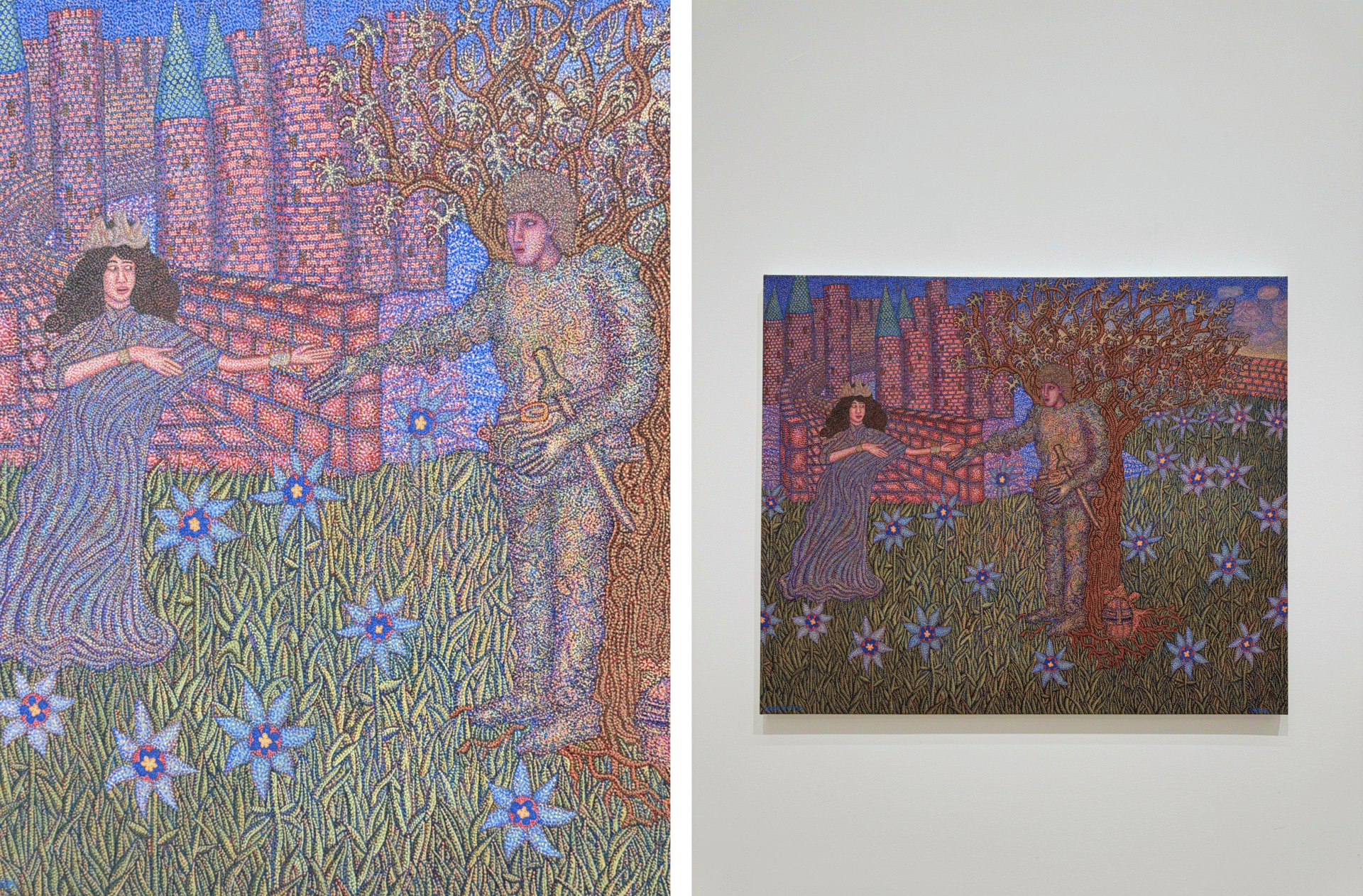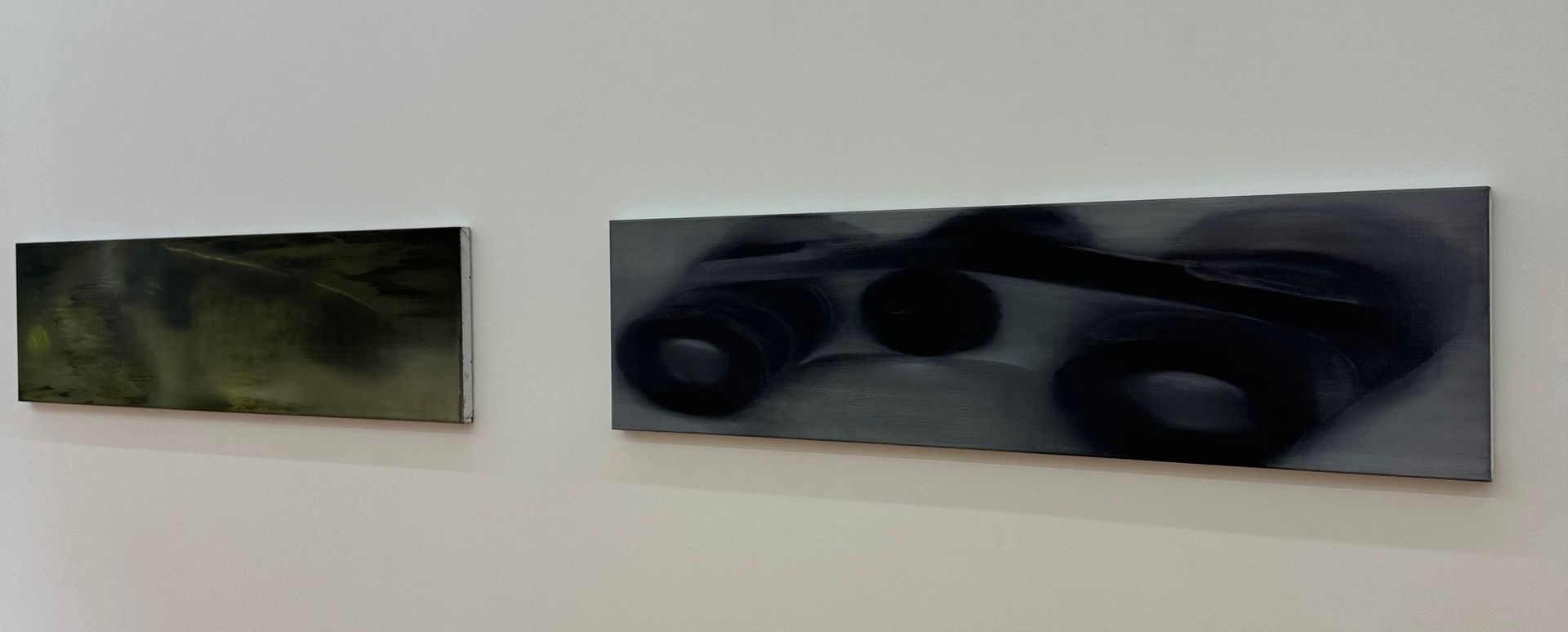- Letters from l'appartement 49C
- Posts
- August Discoveries: When Process Becomes Ritual
August Discoveries: When Process Becomes Ritual
Four NYC exhibitions reveal how contemporary artists transform repetition into revelation
Walking through downtown galleries around 10013 this month, I kept encountering artists who've turned obsessive processes into a form of resistance. Against anxiety, against forgetting, against the speed of contemporary life. These aren't works that reveal themselves instantly. They demand the same patience from viewers that their creators invested in making them, rewarding close attention with unexpected emotional depth.

Castle, 2025, Acrylic on canvas, 30 x 36 inches
Nate Plotkin's Meditative Dots
"Fear of Success" at Shrine NYC
Nate Plotkin's Castle (2025) stopped me as I walked through the back entrance of Shrine. Not because of its fairytale imagery, but because of what happens when you get close enough to see the thousands of individual dots that construct every surface. Working in the pointillist tradition, Plotkin applies each mark of colour separately, a process that takes at least two months per canvas and serves as what he calls "a healthy portal for channeling addictive inclinations."
Depicting a medieval scene: a crowned figure in a flowing robe gestures toward castle walls while a gnarled tree spreads its branches across a field of blue flowers. But the magic lies in the technique—thousands of tiny marks in distinct colours that vibrate optically, creating surfaces that seem to breathe. Up close, you see the pure process from Plotkin. From a distance, a narrative begins to emerge. It's painting as meditation, where the journey matters more than the destination.
What makes this work so compelling is how Plotkin channels personal struggle into something universally resonant. The obsessive application of dots becomes a metaphor for persistence, for building something meaningful one small action at a time.

Branches, 2025, Acrylic on belgian linen with american walnut frame, 12.5 x 18.625 inches
Karel Dicker's Handmade Worlds
"Tamed Flowers" at Nino Mier Gallery
Where Plotkin builds through accumulation, Karel Dicker flows through intuition. His Branches (2025), a luminous painting set in a hand-carved artist's frame, exemplifies his philosophy of not beginning with a concept, but beginning with the surface.
The work depicts a delicate stem curving through a golden hill, rendered in translucent washes that seem to glow from within. The custom frame elevates this intimate landscape into something precious, becoming an altar of sorts.
This approach creates works that feel both ancient and contemporary, like fragments of dreams preserved behind glass. The handmade frames become part of the artwork's meaning, suggesting that in our digital age, there is an importance in the act of crafting something by hand.

Beautiful Mother Catwalk, 2025, Oil on linen, diptych, 88 5/8 x 55 1/8 inches
The Fragmented Visions of Kiki Xuebing Wang
"The Garden of Earthly Delights" at GRIMM Gallery
Among the fifteen artists responding to Bosch's masterpiece, Kiki Xuebing Wang's Beautiful Mother Catwalk (2025) offers the most compelling meditation on how memory distorts perception. This large-scale diptych uses translucent layers of oil paint to create what Wang calls "prismatic surfaces that reflect and refract light."
The work feels like looking through a kaleidoscope of rose coloured glass. The fragmented forms suggest both organic shapes and geometric patterns, with circular motifs that could reference flowers, body parts, or pure abstraction. Wang's technique of layering translucent paint creates depth that shifts as you move around the canvas, making the viewing experience as unstable as memory itself.
This connects to Wang's broader investigation of "how the image itself distorts perception and memory." In the age of social media, where images are endlessly filtered and manipulated, Wang's analog approach to visual distortion feels both nostalgic and prophetic.

Trauerspiele III (right) and Hüljes VIII (left), 2025, Oil on linen, 17.72 x 66.93 inches
Theatrical Ghosts: Mariann Metsis's Palimpsests
"Trauerspiele" at Margot Samel
The most haunting works I encountered were Mariann Metsis's panoramic paintings, where layers of paint are repeatedly applied and scraped away, creating what she calls "palimpsestic" surfaces.
Like Nate Plotkin’s dots, Metsis’s gestures are obsessive in their own way. Repetitive and ritualistic. But while Plotkin constructs his surface point by point, Metsis seems to undo hers with each stroke, drawing inspiration from the German Baroque concept of “trauerspiel.” Is this both artists' way of using process to keep returning to something that resists closure?
Because Sometimes, Process Is the Point
What unites these four approaches is how each artist uses intensive, time-consuming processes to create works that resist instant consumption. In an age of algorithmic feeds and shortened attention spans, they offer a different temporal experience, one that rewards patience and close looking.
Whether through Plotkin's therapeutic dots, Dicker's intuitive flows, Wang's refractive layers, or Metsis's ghostly palimpsests, these artists remind us that making art and looking at it carefully can be acts of radical resistance against the speed of contemporary life.
Though these works have left the walls, they’re still moving through my thoughts. What have you seen lately that’s stayed with you, returning in quiet moments, asking for more of your attention? Write us back if you’d like; we’re always glad to trade stories and reflections.
And if this letter made you think of someone else who’d love it, feel free to pass it along.